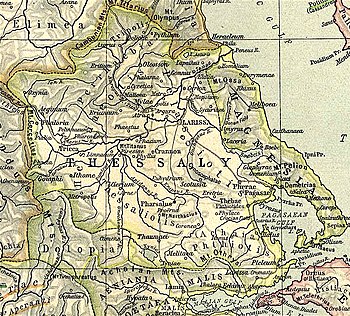Doliche (Thessaly)

Doliche (Greek: Δολίχη)[1] was an ancient Greek city and polis (city-state) in Perrhaebia in Thessaly, situated at the foot of Mount Olympus.[2] Doliche, with the two neighbouring towns of Azorus and Pythion (Pythium), formed a Tripolis.
During the Roman–Seleucid War, the Tripolis was ravaged by an army of the Aetolian League in the year 191 BCE.[3] During the Third Macedonian War the three towns surrendered to the army of Perseus of Macedon in the year 171 BCE,[4] but that same year the Romans reconquered the three.[5] In the year 169 BCE troops arrived from the Roman consul Quintus Marcius Philippus who camped between Azorus and Doliche.[6][7]
The three cities minted a common coin with the inscription "ΤΡΙΠΟΛΙΤΑΝ".[8]
The site is occupied by the modern town of Dolichi;[9][10] when William Martin Leake visited the site in the 19th century, he found two fragments of Doric columns 2 feet 8 inches (81 cm) in diameter in a ruined church, and a sepulchral stone in the burying-ground, together with some squared blocks.[11]
References
- ^ Ptolemy. The Geography. Vol. 3.13.42.
- ^ Mogens Herman Hansen & Thomas Heine Nielsen (2004). "Thessaly and Adjacent Regions". An inventory of archaic and classical poleis. New York: Oxford University Press. pp. 722-723. ISBN 0-19-814099-1.
- ^ Livy. Ab urbe condita Libri [History of Rome]. Vol. 36.10.
- ^ Livy. Ab urbe condita Libri [History of Rome]. Vol. 42.53.
- ^ Livy. Ab urbe condita Libri [History of Rome]. Vol. 42.67.
- ^ Polybius. The Histories. Vol. 28.11, 28.13.1.
- ^ Livy. Ab urbe condita Libri [History of Rome]. Vol. 44.2.
- ^ Mogens Herman Hansen & Thomas Heine Nielsen (2004). "Thessaly and Adjacent Regions". An inventory of archaic and classical poleis. New York: Oxford University Press. pp. 721-722. ISBN 0-19-814099-1.
- ^ Richard Talbert, ed. (2000). Barrington Atlas of the Greek and Roman World. Princeton University Press. p. 50, and directory notes accompanying. ISBN 978-0-691-03169-9.
- ^ Lund University. Digital Atlas of the Roman Empire.
- ^ William Martin Leake, Northern Greece, vol. iii. p. 344.
Sources
 This article incorporates text from a publication now in the public domain: Smith, William, ed. (1854–1857). "Doliche". Dictionary of Greek and Roman Geography. London: John Murray.
This article incorporates text from a publication now in the public domain: Smith, William, ed. (1854–1857). "Doliche". Dictionary of Greek and Roman Geography. London: John Murray.
- CS1: long volume value
- Articles with short description
- Short description is different from Wikidata
- Articles containing Greek-language text
- Wikipedia articles incorporating a citation from the DGRG without Wikisource reference
- Wikipedia articles incorporating text from the DGRG
- Coordinates on Wikidata
- Cities in ancient Greece
- Populated places in ancient Thessaly
- Former populated places in Greece
- Perrhaebia
- Mount Olympus
- Thessalian city-states
- Elassona
- All stub articles
- Ancient Thessaly geography stubs